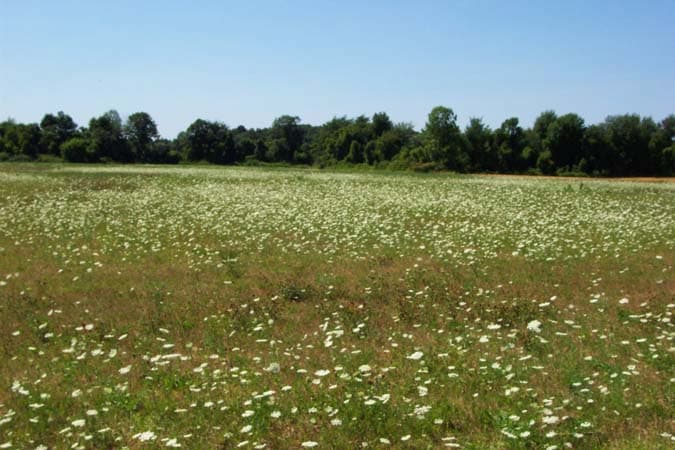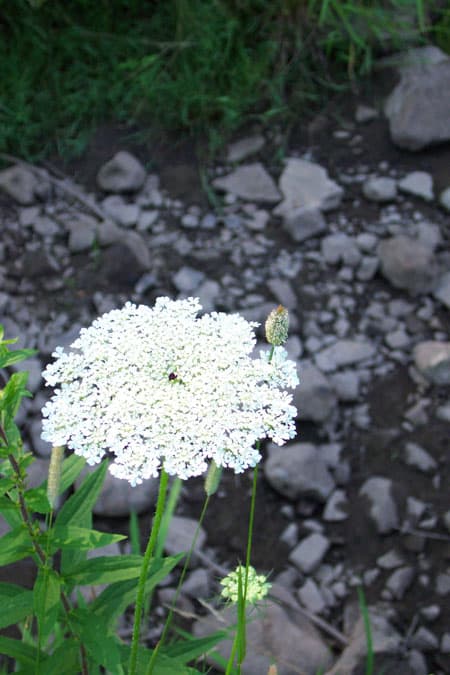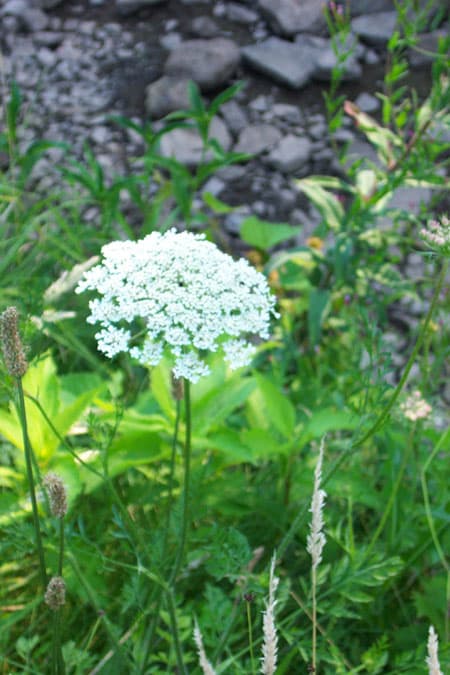How to Grow Queen Anne's Lace Wildflower

About Growing Queen Anne's Lace Wildflower or Garden Flower
Got an English cottage garden? Then, you are most likely growing Queen Anne’s Lace flowers in it. Not surprisingly, this flower originated in Europe. Queen Anne’s Lace plant gets its name for the lacy nature of the flower head. It was very popular during the reign of who other than……. Queen Anne. Also known as Wild Carrot, this wildflower is easy to grow and is prolific in spreading its seeds by the wind. As a result, it is an invasive plant. It is found growing wild along roadsides and in fields almost anywhere in the U.S. The field in the picture above was farmed the prior year. Indeed, a field left fallow for just one year can quickly become a field of Queen Anne’s Lace Wildflowers.
The plant is a biennial that normally grows three to four feet tall but can grow almost five feet in the right conditions. Its flowers are white and sometimes pink. Being related to the carrot, it has a carrot-like root that even smells like a carrot. Some suggest it is edible cooked, while others say no. This doubt exists because Poison Hemlock can be easily mistaken for Queen Anne’s Lace, due to their similarities.
Look closely at a Queen Anne’s Lace flower. You will see a tiny purplish-black floweret in the center of the otherwise white flower? The black floweret is sterile and will not produce seed. Biologists do not know why nature put it there. Perhaps it exists to attract pollinators.
One man’s flower is another man’s weed. Some flower gardeners consider this an attractive flower. Others call it an invasive, or noxious weed. It readily displaces native wildflowers.
Did you Know? Queen Anne’s Lace is a member of the Parsley family.
Queen Anne's Lace Plant Specifications
Flower Colors: White with a single black floret in the center. There are unconmon pink flowers, too.
Flowers Bloom: Summer to early Fall.
Plant Height: Three to four feet tall..
Ideal Soil pH: 5.5 – 7.0.
Hardiness Zones: 3 – 9
Light Requirements: Full to partial sunlight.
Is the Plant Toxic? Yes and No. It can cause skin redness and blisters.
Deer Resistant? Yes. largely. On occasion, they will graze on the flower.
Native To: Asia and Europe. Not native to North America.
Plant Type: Biennial herb.
Botanical Name: Ammi maju
Other Plant Names: Bishop’s Weed, Bishopsweed, Bullwort, Lady’s Lace, Wild Carrot

Are Queen Anne's Lace Plants Edible?
YES!! and NO!!
We found conflicting information about whether this plant is edible. The vast majority of sources say it is indeed edible. edible. Often called “Wild Carrot”, and a member of the Parsley family, these sources all agree that the flowers, seeds and roots are all edible.
Importantly, the University of Minnesota Extension Service states that the plant can cause skin redness and blistering.
Also, this plant looks similar to other toxic plants. Most notably, it appears similar to the highly toxic Giant Hogweed. As a result, it is essential that you know your plants before eating them.
Queen Anne's Lace Medicinal Uses
Do you prepare home remedies using nature’s plants? Queen Anne’s Lace plants have several medicinal uses. Here are some of them:
- It is an antiseptic diuretic for the treatment of skin diseases, cystitis, and prostatitis.
- The seeds help to wash out urinary stones.
- Use the roots as antacids.
- Make a poultice with the roots to relieve itchy skin.

Light Requirements
Queen Anne’s Lace flowers grow their best in full, direct sunlight. When grown in fields as wildflowers, they often receive full sunlight from sunrise to sunset. However, they do grow in partial sunlight, too. With too little sunlight, these light and airy plants grow lanky. For cottage gardens, select a growing location where they will receive six to eight hours of bright sunlight.
How to Grow Queen Anne's Lace Flower Plants
Growing Queen Anne’s Lace is all too easy. They require little or no attention. All it takes to add them to your field or meadow, is to spread a few seeds around. Next, year, you will have plenty of these invasive biennials. After planting them in year one, you will never have to plant them again. If you want some for a garden setting, select a growing location where they can grow undisturbed for years. They will readily reseed the area year after year. As a biennial, you need to initially seed the area two years in a row. Then, the plants will reseed the area for years.
Planting Location Requirements
This hardy wildflower is not picky about the soil it grows in. They thrive in poor soils and dry conditions. Well-draining soil is preferred. About the only requirement, is to grow them in as much full sun as possible.
Water Needs
The plants are tolerant of hot and dry conditions. With wildflowers growing in places where it is impractical to water them, you’ll see they withstand droughts. In your cottage garden, water them only during prolonged droughts. Also, they benefit from a drink of water during periods of very hot weather.
Fertilizer and Nutrient Needs
In most soils, Queen Anne’s Lace flowers do not need extra fertilizers. In the poorest of soils, apply a general-purpose fertilizer in the spring. Then, give them another application before the blooming period begins.
The plants tolerate crowding from weeds and other plants. That’s one of the reasons you see them growing so successfully in fields and along roadsides.
Weed around the plants when they are young. Mulching around the plants in a cottage garden is not required. However, it creates a neat and tidy garden appearance.
No Pruning Required!
Queen Anne’s Lace plants need no pruning. Just plant them and watch them grow. Of course, you can and should remove any wind-damaged or broken stems.
As mentioned previously, the plants will reseed the garden area…. and more. To minimize their invasive spread, remove the flower heads as they begin to die off.
If you want to harvest some of the seeds, leave a few spent blooms on a couple of the plants.
If you want to harvest some of the seeds to plant them in another area or give to gardening friends. just leave a few spent blooms on a couple of the plants.
More on Deadheading Spent Flower Blooms.
Insect and Plant Disease
Insect and plant diseases are not common. This is evident by the profusion of this often growing unassisted as a wildflower in fields all over the country. However, you may experience plant disease problems in wet, humid weather.
For more information see: Plant Problems – Identify the causes and find the cures.
Overwintering Biennial Queen Anne's Lace Wildflower Plants
This hardy biennial plant needs no special winter care. It survives even the harsh winters in the most northern areas of the continental United States. Even if an exceptionally cold winter harms existing plants, the seeds deposited into the soil in the Fall, will sprout and grow new plants when spring sunshine warms the soil. So, when winter cold and snow arrive in your area, rest assured new plants will sprout next spring.
Related Articles
Also, people who read this article about Queen Anne’s Lace wildflower plants will like:
How to Grow Just about any Flower – We’ve got you covered with “How to Grow”‘ guides for all of your favorite flowers.
Please support our site. Shop for:
- rmmatthews100@hotmail.com
- 585-721-6528
- Rochester, NY
©1999-2024 GardenersNet.Com, All Rights Reserved

